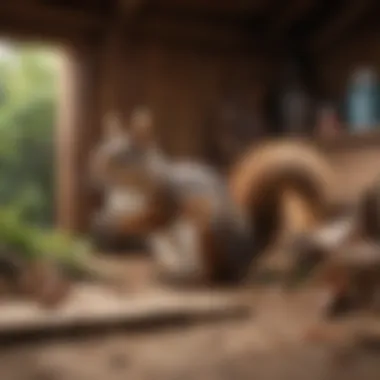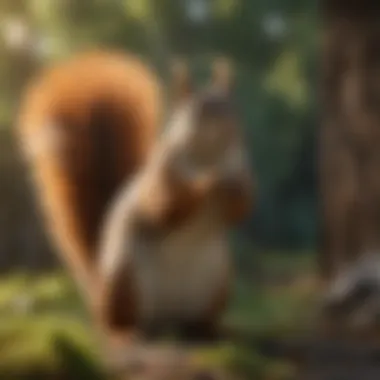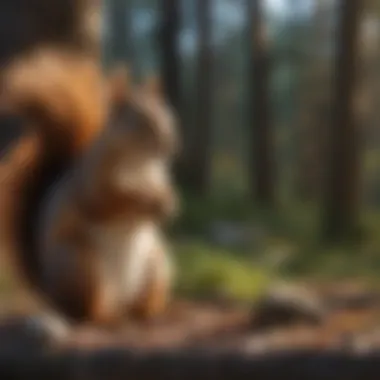Smart Strategies for Squirrel Control in Your Shed


Intro
Squirrels are agile creatures that can easily infiltrate sheds, seeking shelter, food, or even nesting sites. Their presence, while sometimes perceived as harmless, often leads to damage and health concerns. Understanding their behavior is crucial for effective control. In this article, we will delve into various strategies to manage squirrels in your shed. We will cover both preventive measures and effective removal techniques, emphasizing an ethical approach to controlling this wildlife. By the end, readers will have practical knowledge to ensure their shed remains a safe space.
Understanding Squirrel Behavior
Squirrels are known for their cleverness and adaptability. They are primarily attracted to areas with easy access to food, warmth, and nesting material. This often leads them to sheds, where tools, seeds, or stored items can present ample resources. To effectively manage their presence in your shed, one must first recognize the specific behaviors and habits of squirrels.
Key Behaviors to Observe
- Foraging: Squirrels often gather nuts and seeds. They tend to explore every corner in search of food.
- Nesting: Females may build nests in secluded areas, often using materials found in and around the shed.
- Nocturnal Activity: While generally diurnal, squirrels may exhibit increased activity during twilight hours.
Understanding these behaviors enables better monitoring and control measures.
Preventative Strategies
To prevent squirrels from entering the shed in the first place, certain measures can be taken. These strategies focus primarily on modifications to the environment.
Sealing Entry Points
Identify and seal any holes or cracks in the shed. Squirrels can squeeze through surprisingly small openings. Pay close attention to:
- Ventilation Holes: Ensure these are covered with mesh or a fine grid.
- Gaps in Doors and Windows: Install tight-fitting seals to block access.
- Roof and Eaves: Check for loose shingles or boards that may provide an entry point.
Removing Attractants
Minimize the chances of attracting squirrels by:
- Storing food and birdseed in airtight containers.
- Clearing any debris or clutter that may provide nesting material.
- Frequent cleaning to remove any food residues or waste traces.
Ethical Removal Techniques
If squirrels have already established residency in your shed, it might be necessary to employ removal techniques that do not harm the animals. Utilizing humane traps is a common method.
Using Humane Traps
These traps allow for the safe capture of the squirrels without causing injury. When setting traps:
- Place them in areas where squirrel activity is noted.
- Use appealing bait, such as sunflower seeds or nuts.
- Check the traps regularly to ensure trapped squirrels do not suffer.
Once trapped, squirrels should be relocated several miles away from your property, ensuring they have ample foraging opportunities in their new habitat.
Always comply with local laws and regulations regarding the trapping and relocation of wildlife.
Finale
Successfully managing squirrels in your shed requires a combination of understanding their behavior, implementing preventive measures, and using humane removal techniques when necessary. By fostering a rodent-free environment, you not only protect your belongings but also contribute to a balanced local ecosystem. Consider these strategies as you create a safe space for both your possessions and the wildlife that share your environment.
Understanding the Squirrel Problem
Understanding the squirrel problem is crucial for anyone dealing with these agile rodents in their shed. Knowing why these creatures are drawn to your space can help in formulating an effective strategy to keep them out. Squirrels are not only persistent, but their behavior can significantly impact the condition and safety of your shed.
Why Squirrels Enter Sheds


Squirrels seek out sheds primarily for shelter and food. They often find small gaps and holes in structures that provide them access to a warm, dry space. Some common attractions include:
- Food Sources: Birdseed, pet food, or other organic materials can entice squirrels into sheds.
- Nesting Sites: Sheds offer a quiet place to build nests, sometimes using insulation or stored materials.
- Protection from Predators: Squirrels naturally look for safe havens from birds of prey or other threats in the environment.
Understanding these motivations is the first step in tackling your squirrel problem effectively.
Potential Dangers of Squirrels in Sheds
While squirrels may seem harmless, their presence can lead to various problems. Here are some potential dangers:
- Property Damage: Squirrels can chew through wood, wires, and insulation, leading to costly repairs.
- Health Risks: Squirrels can carry diseases and parasites, which may pose health hazards to humans and pets.
- Fire Hazards: Damaged electrical wiring can present fire risks, which is especially concerning in a shed full of flammable materials.
Being aware of these dangers reinforces the importance of taking action against squirrel infestations.
Common Signs of Squirrel Infestation
Identifying signs of a squirrel infestation early can help mitigate damage and prevent further issues. Look for the following indicators:
- Droppings: Small, pellet-like droppings are a clear sign of squirrels.
- Gnaw Marks: Look for tooth marks on wood, wires, or plastic, indicating that squirrels are chewing.
- Nesting Materials: Find shredded items like leaves, twigs, or fabric, which can signal nesting activity.
- Noises: Scratching or scurrying sounds, especially at dawn or dusk, may indicate their presence.
Recognizing these signs promptly can aid in addressing the issue before it escalates.
Identifying the Right Approach
Identifying the right approach to managing squirrel issues in your shed is crucial. This process involves understanding how severe the infestation is and deciding whether to remove the squirrels or implement deterrent methods. Choosing the right strategy ensures that you tackle the problem effectively and responsibly. Moreover, knowing your options allows for flexible and tailored solutions based on your unique shed environment.
Assessing the Severity of Infestation
Before taking any action, it's important to gauge the severity of the squirrel infestation. This assessment helps in determining the most appropriate and effective strategy. Look for signs that indicate the presence of squirrels:
- Nesting materials: Squirrels often use shredded paper, leaves, or twigs to build nests.
- Droppings: Tiny, dark droppings are a common sign that squirrels frequent the area.
- Chewed wood: Damage to the wood structure or furniture may indicate gnawing behavior.
- Noise: Scratching or scampering sounds during the day may suggest active squirrels.
Once you identify these signs, consider the frequency and extent of these issues. A few droppings or occasional noise may mean that immediate removal isn't necessary. Conversely, a large number of droppings or significant damage signifies a more pressing problem that may necessitate immediate action. Assessing these factors allows you to create an informed plan tailored to your specific situation.
Deciding Between Removal and Deterrence
Deciding on removal versus deterrence is a critical decision in effective squirrel management. If you have a minor issue where only a couple of squirrels are spotted, deterrence methods may be sufficient. These can include:
- Use of noise-makers: Devices that emit sounds can discourage squirrels from coming back.
- Scent repellents: Applying certain smells, like vinegar, may deter squirrels from entering.
- Physical barriers: Installing mesh or wiring over entry points can prevent access.
However, if you face a significant infestation impacting the integrity of your shed, removal might be the way to go. This often involves humane traps designed to capture squirrels without harming them. Careful planning and execution are vital to ensure the process is effective and ethical. Be aware of local regulations concerning wildlife removal and follow guidelines to minimize legal issues. The choice between removal and deterrence ultimately hinges on your evaluation of the situation, the severity of infestation, and personal convenience.
Finding the right balance between humane treatment and effective control is key to successful squirrel management.
Preventing Squirrels from Entering Your Shed
Preventing squirrels from entering your shed is crucial for maintaining your items' safety and ensuring the long-term integrity of the structure itself. Not only can these animals cause damage by chewing through wood and insulation, but they can also create unsanitary conditions by leaving droppings and urine behind. Therefore, taking proactive steps to deter their entry is more effective than dealing with an infestation later.
Sealing Entry Points
One of the primary strategies in preventing squirrels from entering your shed is to seal any potential entry points. Squirrels are quite agile and can exploit even the smallest openings. Inspect your shed thoroughly for gaps or holes, paying special attention to the following areas:
- Windows and Doors: Ensure that windows and doors close securely. Use weather stripping or magnetic seals to fortify them.
- Vents: Cover vents with wire mesh or screens to keep squirrels out while still allowing air circulation.
- Roof: Check the roof for loose shingles or gaps. These can serve as easy access points.
- Foundation: Look for cracks in the foundation or walls. Fill these with appropriate materials to block entry.
By diligently identifying and sealing these entry points, you reduce the likelihood of squirrels invading your shed.


Proper Shed Maintenance
Proper maintenance of your shed contributes significantly to squirrel prevention. Regular upkeep not only maintains the condition of the structure but also reduces attractants that invite squirrels. Here are essential maintenance tips:
- Declutter: Keep your shed organized and free of debris. Squirrels may be drawn to piles of tools or materials they can use as nests.
- Food Sources: Avoid storing food or birdseed in your shed. These items can attract not only squirrels but other pests as well.
- Overgrowth: Trim any foliage near the shed. Overhanging branches can serve as bridges for squirrels to access your shed.
Regular maintenance creates an unwelcoming environment for unwanted guests and encourages you to address any issues promptly.
Using Repellents Effectively
Repellents can be a useful tool in your squirrel prevention arsenal. These products discourage squirrels from approaching your shed without causing them harm. When considering repellents, keep the following in mind:
- Natural Repellents: Sprays made from hot pepper or garlic can deter squirrels due to their strong smell.
- Commercial Products: There are many store-bought repellents specifically formulated for rodents. Choose those labeled for outdoor use.
- Frequency of Application: Repellents require regular application, especially after rain. Consistency is key to effectiveness.
Effective Removal Techniques
Removing squirrels from your shed is not just about getting rid of them; it involves understanding effective techniques that can ensure their safe exit and prevent future infestations. The importance of these removal techniques lies in their ability to provide a humane and efficient way of dealing with what can be a persistent issue. Employing effective removal strategies can mitigate property damage, reduce the risk of health hazards caused by squirrels, and maintain a peaceful environment in your shed. Therefore, comprehending the most suitable methods plays a critical role in pest management.
Humane Trapping Methods
Humane trapping methods focus on catching squirrels without causing them harm. This approach is essential for those who care for animal welfare yet need to resolve a squirrel issue. Many types of traps are available, including live traps, which allow for safe relocation. The key to success in using humane traps is placement and baiting.
Steps for Effective Trapping:
- Identify high-traffic areas where squirrels are likely to visit.
- Use appealing bait such as peanut butter, nuts, or seeds.
- Regularly check traps to minimize stress on the animals.
Relocating the caught squirrels to a suitable environment at least five miles away is vital. This ensures they do not return to the original location. Remember that legal regulations may govern the trapping and relocating of wildlife in your area, so it's nature to check local laws before taking action.
Chemical Solutions and Their Applications
Chemical solutions can help manage squirrels, though they should be used with precautions. Certain repellents are available in the market, designed to deter squirrels from specific areas. These chemicals can alter their behavior, making them less likely to frequent your shed.
Common Chemical Repellents Include:
- Capsaicin-based sprays: These use the heat from peppers to deter squirrels.
- Essential oil sprays: Oils like peppermint or eucalyptus can create an offensive scent for squirrels.
It’s crucial to apply these repellents according to instructions, as misuse can lead to adverse effects on both pets and people. Additionally, keep in mind that these solutions usually work best when combined with prevention tactics like sealing entry points. Over time, relying solely on chemicals can become ineffective as squirrels may acclimatize to scents.
When to Contact Professionals
There are times when the squirrel problem becomes too significant to handle alone. If you experience high levels of infestation, or if the squirrels cause severe property damage or health risk, contacting professionals is a wise decision.
When to Seek Help:
- Persistent or large squirrel populations that humane trapping cannot manage.
- Uncertainty about how to handle the problem safely and legally.
- Potential structural damage within the shed.
Professional pest control services have specialized tools and knowledge to deal with issues safely and effectively. They can provide a comprehensive plan to remove the squirrels and implement ongoing prevention strategies. This option often yields long-term benefits, providing peace of mind to shed owners.
It is important to balance effective removal with humane treatment, ensuring that local wildlife is managed responsibly.
In summary, knowing the effective removal techniques is essential for anyone dealing with squirrels in their shed. Whether through humane trapping, chemical solutions, or by seeking professional assistance, addressing the issue with thoughtfulness can lead to satisfactory outcomes.
Post-Removal Considerations


Addressing the presence of squirrels in your shed does not end with their removal. The post-removal phase is crucial for ensuring that the problem does not reoccur. Properly cleaning and sanitizing the space, along with ongoing monitoring strategies, plays a vital role in creating a long-term solution.
Cleaning and Sanitizing Your Shed
Once you have effectively removed the squirrels, the next step involves cleaning and sanitizing your shed. This process is essential to eliminate any health risks associated with squirrel droppings or nesting materials. Squirrels can carry diseases, and their waste can attract other pests.
- Remove Nesting Materials: Start by carefully disposing of any nesting items, such as leaves or fur, found in your shed. Ensure that you wear gloves and a mask during this process to protect yourself from potential pathogens.
- Disinfect Surfaces: After removing debris, clean all surfaces thoroughly. Use a mixture of water and mild detergent to scrub surfaces, followed by a disinfectant solution (like a blend of bleach and water) to sanitize. Pay special attention to areas where squirrels were spotted. This will help reduce any odor and provide a barrier against future infestations.
- Ventilation: Ensure that your shed is well-ventilated to help air out any lingering odors from past squirrel activity. Leaving the doors open for a few hours can be beneficial.
By implementing these steps, you can significantly reduce health risks and improve the overall environment of your shed.
Ongoing Monitoring Strategies
Once your shed is clean, it is vital to establish ongoing monitoring strategies to prevent future squirrel infestations. Being proactive can save you a lot of trouble in the long run.
- Regular Inspections: Schedule regular check-ups of your shed. Look for signs of squirrel activity such as droppings, chewed items, or nesting materials. Early detection can help you address potential problems before they escalate.
- Monitoring Equipment: Consider using cameras or motion detectors around your shed. These devices can alert you to any new activity, allowing immediate response if squirrels attempt to reenter your space.
- Maintain Cleanliness: Regularly clean and keep the shed organized. Reducing clutter will minimize hiding places for any future squirrels seeking shelter.
By putting these measures in place, you ensure that your shed remains a rodent-free environment. Long-term vigilance complements the effective removal techniques, creating a sustainable solution for your shed.
Ethical Considerations in Squirrel Removal
Ethical considerations in squirrel removal play an essential role in addressing the presence of these animals in your shed. It is crucial to approach the situation not just as a pest problem, but as part of a larger ecosystem. Respecting wildlife and considering their role in nature adds depth to the strategies employed for their removal. By integrating ethical principles into the process, one ensures a mindful approach that minimizes harm while solving the issue at hand.
Understanding Local Regulations
Local regulations must be understood before taking any action for squirrel removal. Rules governing wildlife vary greatly depending on location. In some areas, trapping or removing squirrels may be heavily restricted or require permits. Understanding these regulations is not just about compliance; it promotes responsible behavior towards wildlife.
For instance, in certain states, it is illegal to relocate squirrels without a permit. It is, therefore, important to check local laws through wildlife control boards or municipality resources. Ignoring these rules can lead to fines and even legal consequences. As such, reviewing relevant regulations forms the foundation of an ethical approach to wildlife management.
Promoting Safe Wildlife Interactions
Promoting safe wildlife interactions is another critical element in the ethical approach to squirrel removal. This mindset encourages a harmonious existence between humans and local wildlife. Educating oneself and others on the behavior of squirrels can lead to less conflict. Providing suitable habitat for these creatures can also help in redirecting them away from human spaces.
Here are some actions to consider for promoting safe interactions:
- Habitat modification: Create environments where squirrels feel less inclined to intrude into human spaces. Plant native trees and shrubs that meet their dietary and nesting needs yet remain away from sheds.
- Community awareness: Share knowledge with neighbors about humane removal methods. This encourages a community-wide approach to wildlife education and compassion.
- Non-lethal methods: Always consider non-lethal methods of removal. Setting humane traps can safely and effectively deal with the presence of squirrels.
Finale and Final Thoughts
In addressing the presence of squirrels in your shed, a comprehensive understanding of both effective removal techniques and ethical considerations is crucial. The methods discussed throughout this article focus not only on immediate action but also on the long-term management of shed environments. It is essential to recognize that a proactive approach can prevent infestations, thereby saving time and resources.
Among the key points covered are the identification of entry points and the implementation of practical solutions to deter these animals. This involves sealing cracks, maintaining cleanliness, and utilizing repellents effectively. Additionally, understanding the local regulations surrounding wildlife management is important for responsible and lawful practices.
Effective practices include humane trapping methods and the careful consideration of chemical solutions. Always be mindful of the impact that removal techniques possess on local ecosystems, ensuring you promote safe interactions with wildlife.
"Utilizing a mix of prevention and removal strategies paves the way for a balanced approach."
Moreover, continuous monitoring will help ensure that your efforts remain effective over time. By following the guidelines provided, you contribute to creating a safer, rodent-free environment for yourself while respecting the natural habitat of local wildlife.
Summarizing Effective Practices
To succinctly summarize, the strategies for squirrel management in your shed are multifaceted. Here's a brief recap of the effective practices:
- Identifying Entry Points: Regularly inspect your shed for gaps and openings where squirrels might enter.
- Sealing Cracks: Use materials such as steel mesh or caulk to seal potential entry points.
- Maintaining Cleanliness: Keep the shed tidy to avoid attracting squirrels with food sources.
- Using Repellents: Implement both natural and chemical repellents appropriately to deter squirrels.
- Humane Trapping: Employ safe trapping methods when removal is necessary.
- Monitoring: Conduct regular checks to ensure that the strategies you implemented work over time.
Following these practices significantly enhances your ability to manage the presence of squirrels effectively.
Encouraging Responsible Management
Responsible management of squirrels involves recognizing them as part of the local ecosystem. It is vital to take a balanced approach that emphasizes coexistence rather than eradication. This should entail:
- Understanding Local Regulations: Familiarize yourself with local wildlife laws to know what methods are permissible when dealing with squirrels.
- Promoting Safe Interactions: Educate yourself and your community about respectful wildlife practices. This fosters a healthier perspective towards squirrels and other animals.
- Adopting Ethical Removal Practices: When deciding to remove squirrels, ensure humane methods are used, prioritizing their well-being and the safety of your environment.







